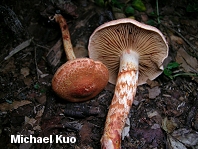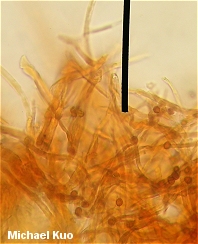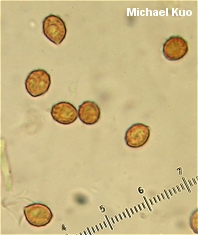| Major Groups > Gilled Mushrooms > Dark-Spored > Cortinarius > Cortinarius bolaris |

|
Cortinarius bolaris [Basidiomycetes > Agaricales > Cortinariaceae > Cortinarius ... ] by Michael Kuo This species is fairly easily recognized (for a Cortinarius) by the bright, brownish red scales covering its cap and stem. Additional identifying features include the cylindric (rather than swollen) shape of the stem, the rusty orange bruising of the stem base, and the fact that the cap and stem are dry. Like other species of Cortinarius it grows on the ground and features a cortina and a rusty brown spore print. Description: Ecology: Mycorrhizal with hardwoods (perhaps exclusively with beech and oaks, though it is sometimes reported under conifers), often in wet areas; growing alone, gregariously, or in small troops; summer and fall; widely distributed in eastern North America, and documented in Costa Rica. Cap: 2.5-8 cm; convex or broadly bell-shaped at first, becoming broadly convex, broadly bell-shaped, or nearly flat; dry; covered with red to brownish red, appressed scales that become more separated as the cap expands, revealing the whitish to yellowish or pinkish flesh beneath. Gills: Attached to the stem; close or crowded; dirty yellowish to dull cinnamon at first, becoming cinnamon to rusty; covered by a whitish cortina when young. Stem: 4-10 cm long; up to 1.5 cm thick; more or less equal; dry; whitish underneath stretched-out, red scales or irregular bands; discoloring and bruising rusty orange to red near the base; usually with a rusty ring zone above the scales and bands. Flesh: Whitish, becoming slowly yellowish when sliced and exposed to air. Odor and Taste: Not distinctive. Chemical Reactions: KOH on cap surface black. Spore Print: Rusty brown. Microscopic Features: Spores 6-8 x 5-6 µ; subglobose to ovoid; moderately verrucose. Pleurocystidia absent. Marginal cells clavate to subclavate. Pileipellis a cutis of orangish elements REFERENCES: (Persoon, 1801) Fries, 1838. (Fries, 1821; Saccardo, 1887; Kauffman, 1918; Kauffman, 1932; Smith, Smith & Weber, 1979; Phillips, 1991/2005; Roody, 2003; McNeil, 2006; Miller & Miller, 2006; Binion et al., 2008.) Herb. Kuo 08180608. This site contains no information about the edibility or toxicity of mushrooms. |
© MushroomExpert.Com |
|
Cite this page as: Kuo, M. (2007, March). Cortinarius bolaris. Retrieved from the MushroomExpert.Com Web site: http://www.mushroomexpert.com/cortinarius_bolaris.html |


